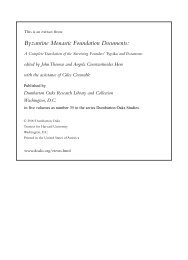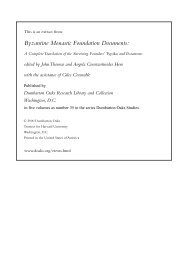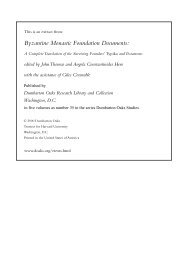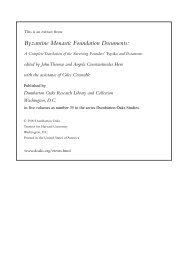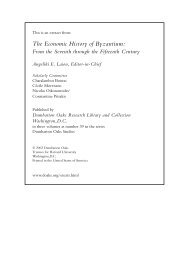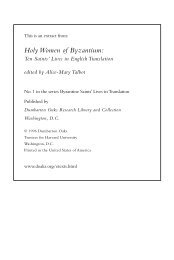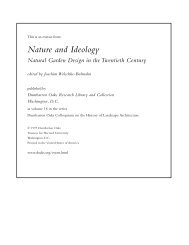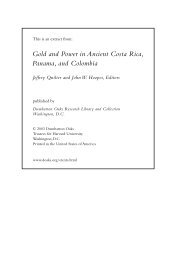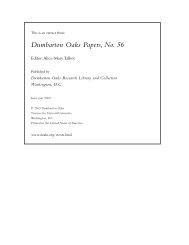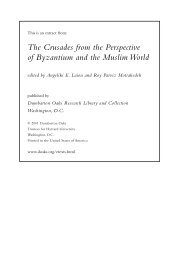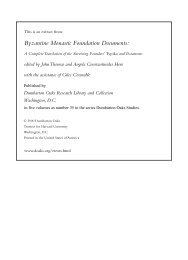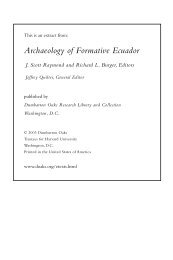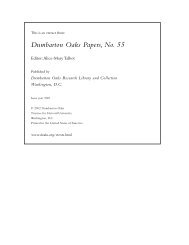28. Pantokrator - Dumbarton Oaks
28. Pantokrator - Dumbarton Oaks
28. Pantokrator - Dumbarton Oaks
Create successful ePaper yourself
Turn your PDF publications into a flip-book with our unique Google optimized e-Paper software.
<strong>28.</strong> PANTOKRATOR<br />
4. Sacramental Life<br />
The Holy Eucharist was to be made available [9] to the monks on feast days. Like the author of<br />
(22) Evergetis [15], the emperor obliges [20] his monks to offer confession to their superior, or<br />
else to the superior’s designee who should be an old and pious monk. In accordance with canon<br />
law, confessors are obliged to obtain permission “through episcopal authorization” to hear confessions.<br />
5. Cenobitic Lifestyle<br />
The emperor implicitly endorses [9], cf. [20] the provisions of (22) Evergetis [9], [22] on sharing<br />
common meals and forbidding secret eating. He also envisions [22] a communal provision of<br />
clothing to the monks. He evidently held [28] alternatives to cenobiticism, such as the kelliotic<br />
lifestyle practiced in several of the dependent institutions of the foundation, in disfavor, but did<br />
not attempt their abolition. There is no ringing endorsement of the superiority of the cenobitic<br />
lifestyle, however, as in (27) Kecharitomene [2], [51].<br />
6. Diet<br />
There were to be two meals daily on ordinary days. The emperor provides regulations for both<br />
dinner [9] and supper [11]. As in (27) Kecharitomene [45], there was a second sitting at dinner for<br />
the servers, here joined also by those who were legitimately delayed from prompt attendance by<br />
their duties. The supper seems to have been more bountiful than usual for many Byzantine monasteries:<br />
it consisted of bread, wine, seasonal fruits and vegetables, and “whatever else is suitable<br />
for eating at dinner.” Fairly detailed prescriptions are found in [12] for both fast days and ordinary<br />
days. The emperor permits the superior to make changes from “strict conformity to the canons” in<br />
the community’s diet during fasts.<br />
7. Personal Possessions<br />
There is no outright endorsement of monastic poverty, as in (27) Kecharitomene [50]. The clergy<br />
stationed at the church of the Eleousa were to receive [32] both monetary and in-kind remuneration<br />
for their services on a graduated pay scale; likewise for the servants in the philanthropic<br />
institutions. Those clergy who participated in the weekly vigil service for the forgiveness of the<br />
emperor’s sins were to receive [31] an additional cash payment, as they would [33] also on the<br />
celebration of the patronal feast of the Mother of God. If they missed the feast, however, they<br />
were to be subject to a fine payable from their personal resources. Also, the priest stationed at the<br />
foundation’s mortuary chapel was allowed [56] to keep any donations offered to him, and the<br />
kelliotic monks in most of the foundation’s dependencies [28] surely also had their private incomes.<br />
8. Care of Sick Monks<br />
The presence of a fully staffed hospital on the premises of the foundation facilitated the care of<br />
monks who fell sick. The emperor instructs [10] the superior to see to it that appropriate care was<br />
provided to an ailing monk in his cell. Alternatively, a six-bed sanatorium (triklinarion) could be<br />
made available for rest and recuperation.<br />
9. Bathing<br />
Following a gradually liberalizing attitude towards the use of baths by monks observable since<br />
[ 729 ]




